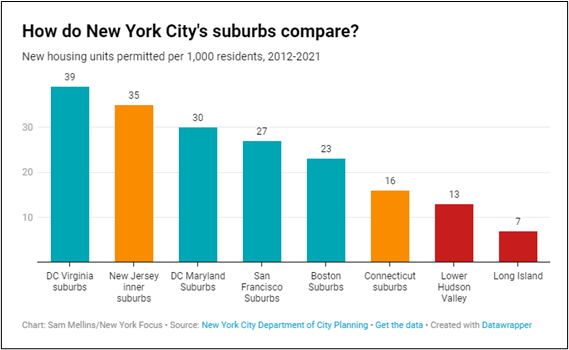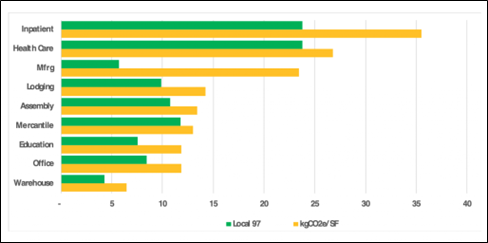NYC housing has a suburb problem
Insufficient suburban housing development is complicit in making rents so high in NYC + initial Local Law 97 rules get published.
This week
NY suburbs don’t build enough
New carbon emission rules
Post 421A expiration, dev. sites are slow to sell
NYC suburbs are part of the problem too
NYC has a housing problem. Specifically, it “builds less housing per capita than almost any major city in the US,” according to NY Focus. What’s interesting to consider is how the surrounding suburbs might exacerbate this problem.
NYC suburbs of Connecticut, Hudson Valley and Long Island built fewer housing units than any suburbs on the East Coast according to Furman Center data from 2010-2021, at approximately 13 units of housing per 1,000 residents.
Zoning is partially to blame. More than 50% of suburbs with access to public transit had zoning restrictions in place that prevented all but the smallest multifamily developments. This presents untapped opportunities for new housing to be built and to service an unmet demand of renters.
New York State does not have any overarching state law to prevent local efforts to strike down up-zoning requests, like California, Orgon, or New Jersey do. This contributes to the issue also.
The rate of construction and the regulatory framework in suburbs matter a great deal because suburbs act as a relief valve that absorb a) those priced out of New York City, or b) those who specifically want to be in suburban areas. Low construction rates in the suburbs give NYC the bulk of the responsibility for housing people. It’s possible NYC’s rental market could be radically more affordable if its neighboring municipalities picked up the slack and provided viable housing alternatives. By and large, NYC’s 5 boroughs are the only housing option in town for much of NYC + its surrounding suburbs. If I can’t buy a nice home in CT because it’s too pricey, maybe I will just rent a nice place in NY for a while.
Source: NY Focus, taken from NYC Department of City Planning
The rules for Local Law 97 come into focus
NYC’s landmark environmental law, which passed in 2019, is designed to curb CO2 emissions from buildings in the city. This law stands alongside other measures like the ban of fossil fuel use in new buildings (starting in 2024, with full implementation in 2027) as part of a cogent strategy to be more climate smart. The Department of Buildings released a new set of guidelines, as the city inches closer to putting Local Law 97 into effect. Below is a summary of what the 28-page document said.
It outlined methods for measuring carbon emissions from buildings – across energy use types and building uses. (i.e. electricity is cleaner than gas, and multifamily emits less CO2 per SF than data centers).
It listed allowable deductions to carbon emissions that owners can use to make sure their net energy use is compliant with Local Law 97. According to the proposal, owners can buy Renewable Energy Credits (RECs) to offset their carbon footprint.
The BIG catch: RECs can only be used to offset building emissions coming from electricity. Much of property CO2 emissions come from the use of oil / natural gas. This would remove owners’ abilities to invest in renewable projects as a means to bypass compliance to Local Law 97.
The other problem: NYC credits that are purchased must in some way contribute to improving / adding to the electric grid in the 5 boroughs. The Champlain Hudson Power Express (CHPE) would be a perfect project to buy credits from - when completed, it will raise megawatt capacity in NYC by 1/3. Unfortunately, the project won’t be operational until Spring of 2026, according the CHPE’s website, which is past the initial 2024 due date for carbon emission reductions.
The Department of buildings will host a public hearing at 11 AM EST on 11/14/22 to field any public objections, or commentary. Comments on the proposal are due prior to then. It’s not clear whether the proposal needs a vote to pass, or if it’s just a symbolic hearing to allow grievances to be aired. The full text of proposed guidelines can be found here.
Note: Properties designated for health-care use produce more carbon emissions than manufacturing properties. However, local law 97 is more lenient to health care providers and will allow them to emit nearly 5x the amount of C02 that manufacturing properties produce. Source: IotaComm
After 421A tax abatement expiration, land sales are sluggish
In Q4 2021 and Q1 2022, the quarters leading up to the expiration of the 421A rule, NYC issued +650 permits a quarter for new buildings, or 37% more than the median quarterly permit issuance over the last 10+ years.
The development landscape 9-12 months ago was very different than it is today. Interest rates were lower and rents were growing at double digit rates YOY. This may have contributed to a speculative rush to buy land sites in the hope to flip them.
Today, land sales have slowed down. According to JLL’s Bob Knakal, few if any 421A development sites are trading hands. This may be because of pricing – investors who put footings into their land sites overvalued the benefits that 421A eligibility would have on their land, post program expiration. The problem may also be low sophistication. Sub-optimal building plans made by novice developers, overshadow the economic benefits that tax reductions may bring.
Institutional developers like Naftali Group and Extell Development are pushing ahead albeit opting for more condo construction instead of multifamily units.
Sources: The Real Deal, Department of Buildings, NY Focus
This update was initially published on October 17th, 2022




